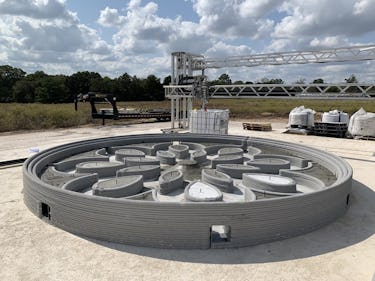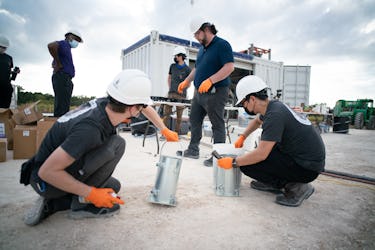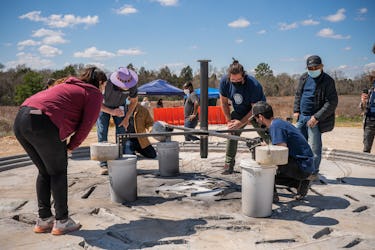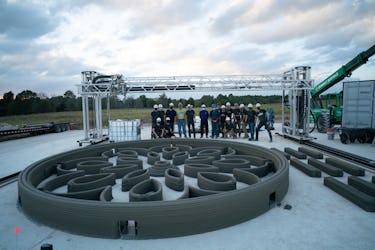Artemis Generation Students Design 3D-printed Rocket Pad For Lunar Missions with NASA & ICON
ICON’s Technology Delivers World’s First 3D-printed Rocket Pad; One Step Closer Towards Lunar Infrastructure
AUSTIN, TX, MARCH 10, 2021 - From 3D-printed homes on Earth to the development of space-based construction systems for the Moon, ICON announced today its proprietary technology has delivered the world’s first 3D-printed lunar launch and landing pad at a Texas Military Department location, Camp Swift, just outside of Austin, TX.
When it comes to the future of space exploration, it is only fitting that the next generation of engineers and scientists play a vital role in imagining that future. A team of undergraduate students from 10 colleges and universities across the United States – members of the Artemis Generation – are turning their creative ideas into reality. They designed a reusable landing pad that could be 3D printed from materials found on the Moon. In October 2020, ICON, an MMPACT partner, helped the students build a subscale prototype pad at Texas Military Department’s Camp Swift location in Bastrop, Texas, using a cement-based material and a gantry print system developed by ICON. The teams reunited again at Camp Swift last week to conduct static fire with a rocket motor on the 3D-printed rocket pad.
“This is the first milestone on the journey to making off-world construction a reality, which will allow humanity to stay - not just visit the stars,” said Michael McDaniel, ICON’s Head of Design.

The novel concept – called the Lunar Plume Alleviation Device, or Lunar PAD – focuses on solving the problems caused when the force of an engine's powerful exhaust meets the dusty lunar surface. The design features a series of petal-like channels that send exhaust upward and outward, minimizing the amount of dust lofted during launch and landing. The student team presented a paper on the Lunar PAD concept Jan. 12 at the American Institute of Aeronautics and Astronautics' 2021 SciTech Forum.
The students first proposed their landing pad solution during the summer 2019 NASA Proposal Writing and Evaluation Experience – a 12-week training course crafted by John Dankanich, chief technologist at NASA’s Marshall Space Flight Center, as part of the Lucy Student Pipeline Accelerator and Competency Enabler (L’SPACE) Academy, to expand and diversify the pool of high-quality, selectable proposals for new concepts and technologies that meet NASA's needs. Their top-ranking proposal won funding and support from NASA subject matter experts to mature the concept. In June 2020, the team again presented to Marshall experts at a virtual Design Readiness Review and secured funding to print and test a subscale version of the pad.

“The proposal addressed a technology pain point, as the project enables a safe and reusable landing pad required for sustainable lunar exploration,” Dankanich said. “The team worked many hundreds of hours, engaged NASA subject matter experts, and went from concept formulation to a preliminary design. They then turned that design into reality with the subscale construction, all in a few short months.”
The pad was comprised of essentially two layers. A “roof” where a rocket launches from or lands on, and a series of channels below that to safely redirect the exhaust. Slits in the roof allow exhaust from rockets to travel into the carefully designed channels that direct the exhaust flow to the edge of the launch pad where it exits through specialized vents. A central cone and dividers support the weight of the rocket and pad roof. A wall surrounds the structure, capturing any lunar dust particles that become mobilized during a launch or landing.

To test the complex design and its ability to be 3D-printed, the team worked with experts from Marshall's Moon-to-Mars Planetary Autonomous Construction Technologies project, or MMPACT. MMPACT is funded by NASA’s Game Changing Development program and aims to develop, deliver, and demonstrate on-demand capabilities to protect astronauts and create infrastructure on the lunar surface via construction of landing pads, habitats, shelters, roadways, berms and blast shields using lunar regolith-based materials.
Dankanich described Mike Fiske, an MMPACT project lead, as “one of his heroes, for not just mentoring the Lunar PAD team, but truly making them a part of the NASA team.” Fiske coordinated with NASA subject matter experts and other government, industry, and academic partners in support of the project.
Fiske and the Lunar PAD student team returned to Camp Swift last week to see how their prototype would hold up under the extreme high temperatures and stresses created by a rocket engine. Instrumentation to measure temperature, strain, and exhaust flow behavior was integrated into the pad during printing. The Sounding Rocketry Team at Texas A&M University in College Station assisted with hot fire testing and fabrication of the rocket motor. Based on preliminary analysis and results from instrumentation, the lunar launch and landing pad performed as designed.

"It has been a pleasure working with these students over the last year and helping to advance the state of the art in planetary launch and landing pads,” said Fiske, an in-space manufacturing engineer with Jacobs Engineering Group Inc. in Marshall's Space Technology Development Branch. “The results from this project contribute strongly to our future knowledge of lunar launch and landing pads and get us one step closer to lunar infrastructure.”
"While the Lunar PAD team is a very diverse group, we have always been bound together by our passion for the continued exploration of space," said Andres Campbell, a Principal Investigator for the Lunar PAD team. "We are looking forward to the continued success of the Lunar PAD project with future publications and other academic or professional work."

About ICON
ICON develops advanced construction technologies that advance humanity. Using proprietary 3D printing robotics, software and advanced materials, ICON is shifting the paradigm of homebuilding on Earth and beyond. For more information, visit www.iconbuild.com or follow the conversation on Instagram, Twitter, Facebook, YouTube (@ICON3DTech).